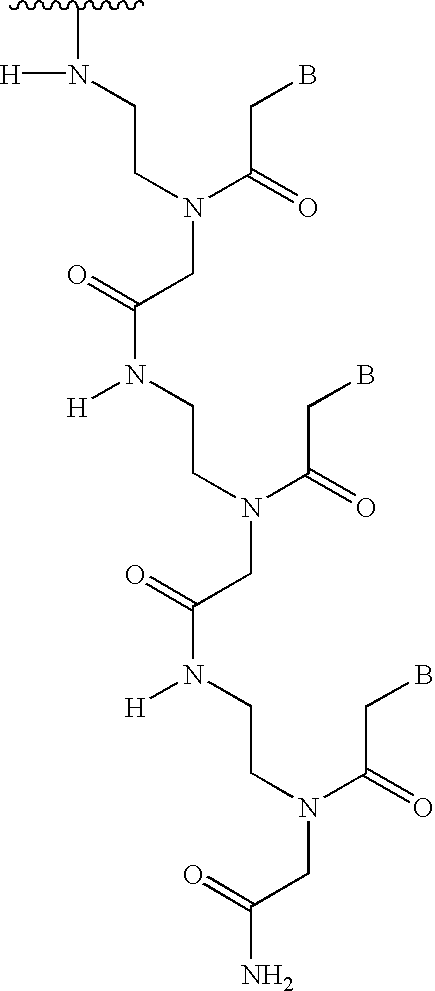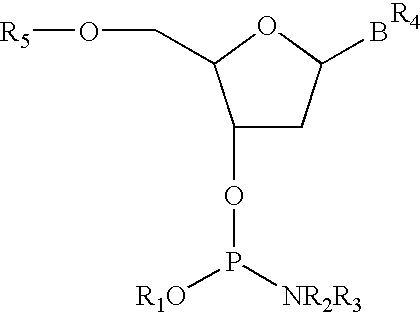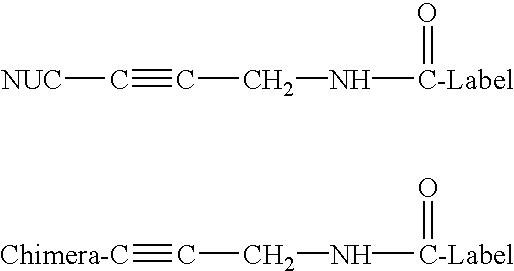PNA-DNA chimeric probe arrays and methods of use
a chimeric probe and array technology, applied in the field of enzymology and nucleic acid analogs, can solve the problems of inefficiency of both events, and achieve the effects of improving the specificity, reducing the cost of production, and improving the efficiency of both events
- Summary
- Abstract
- Description
- Claims
- Application Information
AI Technical Summary
Benefits of technology
Problems solved by technology
Method used
Image
Examples
example 1
Labelling of PNA-DNA Chimera
TAMRA and NTB Labelling
Labelling is performed with 5 mg of NHS ester of TAMRA or NTB dissolved in 100 .mu.I DMF or NMP and 10 .mu.l DIEA. The labelling mixture is added to the support bound PNA-DNA chimera and allowed to react for 2 to 18 hours (typically overnight). The support is washed following the labelling with DMF and subsequently DCM prior to cleavage.
CDPI Labelling
CDPI.sub.3 is attached to the chimera by three consecutive couplings of Fmoc-CDPI (Lukhtanov, 1995) to the amino terminus of a PNA-DNA chimera to give CDPI.sub.3 -labelled PNA-DNA chimera. The CDPI monomer unit, 1,2-dihydro-(3H)-pyrrolo[3,2-e]indole-7-carboxylate, protected with Fmoc (5 mg, 0.012 mmole) is dissolved in 100 .mu.l NMP and activated by 0.95 equivalents HATU (0.2M in DMF) and 2 equivalents DIEA (0.4M in DMF). After one hour at room temperature, the activated Fmoc-CDPI solution is added to the support bound chimera and allowed to couple for another hour at room temperature. ...
example 2
FIG. 4 shows ligation experiments where a ligation mixture contained a template and two probes at a final concentration of 1 .mu.M each, 1.times.T4 DNA ligase buffer [50 mM Tris-HCl, pH 7.5, 10 mM MgCl.sub.2, 10 mM dithiothreitol, 1 mM ATP, 25 .mu.g / ml bovine serum albumin], and 1,000 units T4 DNA ligase (New England BioLabs, Beverly, Mass.) in a volume of 50 .mu.l. T4 ligase can also be purchased from Boehringer-Mannheim. Approximately 70 units of NE Biolabs T4 DNA ligase is equal to 1 Weiss unit of Boehringer-Mannheim T4 ligase. The same reactions were also conducted without ligase. After incubation at 22.5 to 25.degree. C. for 3 to 4 hours, the reaction mixture was heated at 80.degree. C. for 20 min. and then stored at 4.degree. C. Five .mu.l of the reaction mixture was analyzed by (15%) polyacrylamide gel electrophoresis (PAGE) under denaturing conditions (7M urea) at 120-140 V for 20-60 min (FIG. 4A). Ligation of 5'-phosphate oligonucleotides (DNA2, DNA4 or DNA5) to an ...
example 3
MALDI-TOF Analysis of Ligation Reaction
Mass spectra were acquired on a MALDI-TOF MS (Voyager DE, PerSeptive Biosystems, division of PE Corporation) workstation. Desalted samples are mixed 1:1 with matrix solution consisting of 50 mg / ml 3-hydroxy picolinic acid, 50 mM ammonium citrate, and 30% acetonitrile, and are spotted onto a sample plate. Time-of-flight data from 20 to 50 individual laser pulses are recorded and averaged on a transient digitizer, after which the averaged spectra are automatically converted to mass by data processing software. FIG. 7 of ligation reactions. A 3' biotinylated 20 nt oligonucleotide (mass 6303) and a PNA-DNA chimera (mass 2539) were hybridized to 5' biotinylated DNA template 38 nt (mass 12358). FIG. 7A shows MALDI-TOF Mass Spectroscopy analysis of the mixture without ligase. The analysis shows only ion peaks of the starting materials. When the ligation mixture contains ligase (FIG. 7B), a ligation product is evident with the expected mass of 8823.8.
t...
PUM
| Property | Measurement | Unit |
|---|---|---|
| Fraction | aaaaa | aaaaa |
| Time | aaaaa | aaaaa |
| Time | aaaaa | aaaaa |
Abstract
Description
Claims
Application Information
 Login to View More
Login to View More - R&D
- Intellectual Property
- Life Sciences
- Materials
- Tech Scout
- Unparalleled Data Quality
- Higher Quality Content
- 60% Fewer Hallucinations
Browse by: Latest US Patents, China's latest patents, Technical Efficacy Thesaurus, Application Domain, Technology Topic, Popular Technical Reports.
© 2025 PatSnap. All rights reserved.Legal|Privacy policy|Modern Slavery Act Transparency Statement|Sitemap|About US| Contact US: help@patsnap.com



